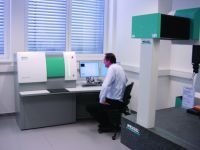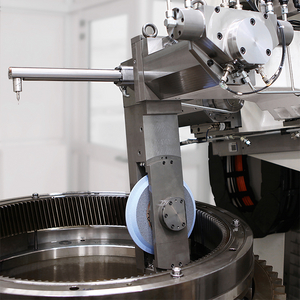Wenzel Examines Computed Tomography

Andy Woodward, president of Wenzel America, has written the following article on why manufacturers can't afford not to use computed tomography: Computed Tomography (or CT, as it is commonly known) has been around for years. Most are aware of CT technology as it has been applied in medicine, where CT "scans" take multiple x-ray slices that enable doctors to view a complete 3-D image of a patient's body. The completeness and clarity of information provided by CT technology has improved dramatically over the last several years - and its benefits are nothing short of amazing when compared with merely looking at and probing patients from the outside.
Industrial CT offers the same huge step forward when compared to having engineers attempt to understand or repair a component or an assembly only by probing from the outside - with one important difference: Industrial CT machines, such as those produced by Wenzel, add an even greater degree of dimensional accuracy to its images. A modern CT system can measure and examine both the inside and the outside of a part in extensive detail. It can measure assemblies to determine why they don't work or go together very well, and it can measure multi-material assemblies, isolate individual components of different densities, and even analyze the material flow in plastic and composite parts.
CT Machines: Do More, Used Less
If CT machines offer so much more than CMMs and other similar devices, why are relatively few CT machines purchased and sold? Is it a matter of price? If it is, I would challenge any manufacturer that they cannot afford to NOT have a CT machine - or at least have access to one.
And if it's a matter of awareness, my hope is that this article will familiarize you with the capabilities of a modern CT system such as those manufactured by Wenzel.
Three words to remember are compromise, liability, and reputation.
Compromise. Throughout the history of industrial metrology, quality and R&D engineers have had to compromise to make decisions about what to measure based on the existing technology and the time available to them. They have asked, "What are the dimensions I believe to be critical?", "What do I think is wrong with my component or complex assembly?" and "Why doesn't it work?"
With CT, engineers can capture the complete part (the shape and dimensions, the density, the material flow, and any porosity, cracks, or inclusions). This data is stored in "Voxels" (a 4-D pixel, as opposed to a regular 2-D pixel). At Wenzel America we call this the "Part DNA." It is everything that the part is; everything that defines the part or finished assembly.
If engineers have the Part DNA, they can do everything they need to do, now or later - inspection, NDT, archiving, reverse engineering, and investigation. And if a manufacturer has invested the time, effort, and money required to develop a significant product, such as a new smart phone, the cost to keep its "Part DNA" on file is insignificant compared to the potential benefits.
Liability. The engineer also has the option to store this Part DNA for later measurement or for full archiving of everything to do with the part for future "protection" of the supplier. This leads to the second word - liability.
Often the parts measured by CT machines have quite low value in themselves, but failure of such parts in the field can lead to disastrous effects, particularly where human safety is an issue. This can be aircraft or automobile parts, but also medical devices and electrical equipment or connectors. Less complex consumer products sold in the millions also can fail with equally expensive effects on recall and company reputation. Archiving the Part DNA allows them to be re-analyzed in the event of a field failure to provide rapid correction or disprove a potential lawsuit.
Expert investigators can also use CT data to prevent counterfeiting of copyrighted or patented products, again reducing liability and retaining profits. In fact the "Part DNA" generated by the CT system could be a part of the patent.
Potential users of CT data can ask themselves, "What is the cost of not using CT data to make sure I have no future liability?" Given the likely answer the price of a CT machine or the use of a CT bureau service can become extremely attractive.
Reputation. A final word to consider is reputation. What is the cost of a recall to a car company because something doesn't work? What is the cost of loss of market share to a medical device manufacturer or antiperspirant manufacturer if the device does not function properly? Besides potential lawsuits, the loss in reputation and market share could be a financial disaster.
Industrial Computed Tomography is not too new, but the justification and the reason for its existence (its Part DNA) has not been explained well enough so far to its potential customer base. Rather than believing that CT is just too expensive, the real cost of not using the technology must be fully understood. The return on investment in a relatively "expensive" machine can be realized in days, not years.
Doctors and hospital administrators use the approximately 20,000 medical CT scanners installed in the United States so as not to compromise patient care and diagnosis. But perhaps they also have and use them to reduce their potential liability, and to ensure that they do not damage their reputation.
Andy Woodward is president of Wenzel America Ltd., a wholly-owned subsidiary of Wenzel Group of Germany. The company sells and supports the full range of Wenzel products, including all of the industrial CT scanners produced by Wenzel Volumetrik. The exaCT brand offers a variety of machines, from low-cost bench-top systems to very powerful models capable of scanning multi-material assemblies and aluminum castings.





